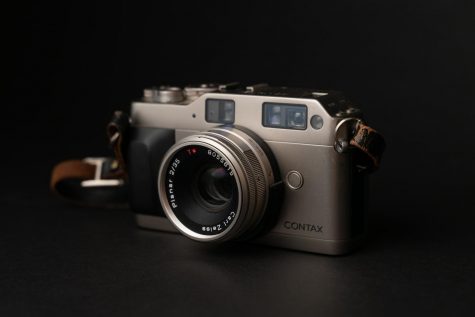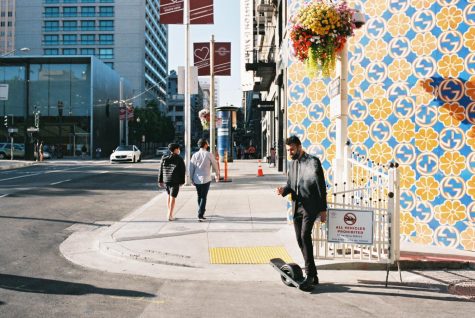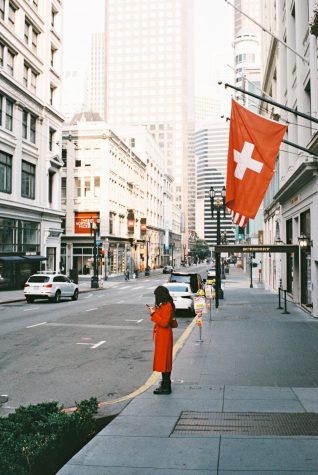My relationship with the Contax G1 is complicated. When I first looked into picking one up, I wanted something that every photographer wants at some point; a camera that could do it all. I was, at the time, just getting into photojournalism and street photography and was using a Canon Elan IIe. I love my IIe, but it is not a subtle camera, and Canon’s lenses are not built for zone focusing. So, I was in the market for a camera that was compact, discrete, had a manual or zone focus option, and a good lens lineup, all without breaking the bank.
This is a tall order, as any photographer knows there’s no ‘perfect’ camera; there’s only the camera you can get your hands on. So, after some research, I settled on this champagne manifestation of ‘90s affluence.
My Personal Feelings

Nothing quite screams “‘90s technology” like champagne colored electronics. So just by looking at the eBay listings you can get a pretty good feel for the Contax G1. Holding it in your hands is a completely different experience, however. It has a sturdy heft to it, and you can get a feel for the amount of hardware that’s stuffed inside the camera. Ergonomically speaking, it’s damn near perfect for what it’s trying to be. The metal body is complimented by a black rubber grip on the right-hand side of the camera, providing excellent grip on both the front and back of the camera, allowing for easy one-handed use. The dials all work splendidly.
The viewfinder is especially amazing. The camera will automatically detect the focal length of any compatible lens mounted on it and will adjust the finder window to provide accurate framing, with parallax correction kicking in when you half press the shutter button. The focus distance and shutter speed are displayed on a green LED on the bottom of the viewfinder, which is useful because the autofocus is infuriatingly inconsistent, which I’ll get into later.
The camera is feature packed as well; shutter speeds from 1-1/2000ths, exposure compensation, a manual focus mode, active infrared autofocusing, aperture priority mode, manual ISO and a double exposure mode. This makes the camera feel full, and I’m certain Contax really designed their heart out on this camera, but some of these features are either finicky or just plain don’t work.
The continuous autofocus mode might as well not be there. Instead of maintaining a continuous drive of focus like a single lens reflex (SLR) would, it simply resamples the focus point every second or so and tries to focus on whatever it’s pointed at at that exact time. It’s easier, and quicker, to leave it in its single focus mode and half press the shutter yourself.
The autofocus is inconsistent. Most of the time, you’re fine, but something like a fingerprint smudge on the infrared beam window can cause it to hunt. I’ve also missed focus on simple scenes before. It doesn’t happen often, but it does happen often enough that you feel like you always have to double check the viewfinder’s focus scale. This makes the camera feel very sluggish. Rangefinders, I feel, are meant to be fast, precise cameras. If I’m out doing street photography or journalism and I come across a fleeting scene, I need my camera to be reliable and ready. But often I’m raising the Contax up and becoming frustrated with the way the camera’s automatic features seem to take their time.
This brings me to my next point: the manual focus. This is the point that sold me on the camera, on paper. I wanted something that I could set the focus and aperture, and be ready to click a picture at a half-second’s notice. Unfortunately, the manual focus feature on this camera is built with the same leisurely flaws of the automatic features. First of all, the manual focus ring does not click into place. It spins freely, and it’s right at the edge of the camera. This makes it far too easy for your shirt or camera strap to catch the wheel and change your focus. I cannot tell you how frustrated I’ve been when I’ve meticulously set my focus distance to 3 meters, let my camera rest for a moment, come across a scene, snapped my shot, only to find that the focus wheel had somehow been turned to infinity. Designing the distance scale with the same click-sets of the shutter speed ring would have been a huge improvement. Sadly, there’s another huge flaw in the design, and that’s that the camera does not pre-focus when in manual mode.
This is my most pertinent complaint. Setting the distance doesn’t actually focus the lens, you have to half-press the shutter to focus the lens, and it has a lag of a full second before the shutter will release. That single second has caused me to miss many shots. It doesn’t seem like a lot, but when things are happening quickly around you, a second is a long time. You can half-press the shutter to pre-focus the lens, but it’s clumsy, not very comfortable, and good luck not accidentally pressing the shutter all the way and burning a frame. Overall, the manual focus mode is a headache, and the autofocus is not reliable enough to use for fast-moving situations.
I still love this camera. Even after all of its failings, its dumb kind-of-silver color, and its tempermental ‘90s attitude, I’ve taken some of my favorite photos on it. The metering is excellent. I always overexpose my color negative film by at least half a stop, and the Contax has never given me a bad exposure. The lenses that Contax built for this thing are known to be among the best ever made. I’ve mostly used the 35mm f2, and it’s the sharpest glass I’ve ever used on 35mm. It feels amazing in your hand, it’s compact and it’s relatively cheap.
What was the camera designed to do?

Contax’s 35mm cameras have always had the air of luxury associated with them. They were built for upper middle and high class moms and dads to purchase as an affluent status symbol they could show off at parties and on vacations. These Contaxes were designed with luxury, functionality and class in mind.
Does the Camera do what it was designed to do, and how well?
Well, as a status symbol, they’re ironically relatively cheap now, so 0/10. But, as a camera you can take on a trip, or to a party, it works excellently. The ONLY issue is that finicky autofocus that can get you a perfectly sharp photo in pitch darkness but will sometimes give you a blobby mess on the simplest of scenes. However, the metering, ergonomics and image quality are all top-rate. I give this camera an 8/10 overall. If it stays in its lane, it’s hard to beat.
What is it good at?

Honestly, if you’re looking for a stylish ‘90s camera to take to parties, on trips with your friends or just as a luxury walkabout photo-maker, you won’t find anything better. The image quality is the camera’s biggest strength. The metering and the incredible lens quality create an unbeatable duo. The main reason I can’t bring myself to sell mine is the negatives this thing makes. When it hits its mark, it’s dreamlike. This camera could bully the T2 back to being affordable if people cared more about functionality than status, and if you’re a reasonable person looking for a T2, I’d say just forget it and pick up one of these. For starters, the G1 with a 35mm f2 and TLA 140 flash will run you $600-800, about the same price as a T2. With the G1, you get the option of full manual, a faster 35mm lens (plus the other lens options), and a better-designed body. That is, if you think you can sacrifice the pocketability and don’t mind manually setting your aperture (just stick it at f5.6 and forget about it).

What is it bad at?
No matter how much I love it and how much practice I put in, it just feels sluggish. For the street, the Leica Ms, CL/E, XAs, and SLRs just work better. Having that physical, mechanical connection between the button and the shutter is so useful. Being able to zone focus with the lens without having to worry about focus creep makes my walkabouts more enjoyable. The G1 is just not a nimble camera. As well, the limitations of the active autofocus system extend beyond its temperament. The infrared beams will register a glass pane as the focus point, so you will not be able to focus through transparent barriers. If you don’t keep the infrared windows clean, the focus will hunt. Sometimes, it will just hunt anyways.
Personal recommendations
Want a party/travel camera? Get one with the TLA 140 or TLA 200 flash and pretend you’re a rich ‘90s soccer mom in Orange County; you’ll have a great time. Want a nimble, fast, real-world ready rangefinder camera for the streets? Get an M or a CL/E, or if you want autofocus and dont mind SLRs, just get a Canon Elan (or an EOS 3 if you’re nasty).
I will say, if you have a slower, more methodical style of street photography, you might really like the G1. But, if you’re like me and like to move fast and snap fast, I would pass it up.
The Contax G2 makes up for a lot of the G1’s shortcomings. I haven’t used one, but it has a better layout and the manual focus is controlled by a dial on the front of the camera, so less chance of knocking your focus to infinity by accident. The autofocus is allegedly marginally improved. The camera has a pre-focus button on the back that’s more easily reached with your thumb. However, it’s three times the price, the same color, and was designed for the same uses. So, with that in mind, I’ll keep my cheap G1. The lenses are the star of the show anyways.
For those with no attention span: Image quality is incredible due to legendary lenses, AF and manual focus features are too finicky for either to be used reliably, metering and ergonomics are top-notch, can’t beat it for a travel or party camera but just can’t keep up with other cameras on the streets, 8/10.





Daniel Rider • Apr 15, 2021 at 7:42 pm
Great article, I just ordered one and while disappointed to hear that setting the manual focus is not really a way to avoid AF lag, I’m hoping the lenses and other features will help me slow down and take some solid more planned shots. Congratulations on your recovery from the injury. Happy shooting!!